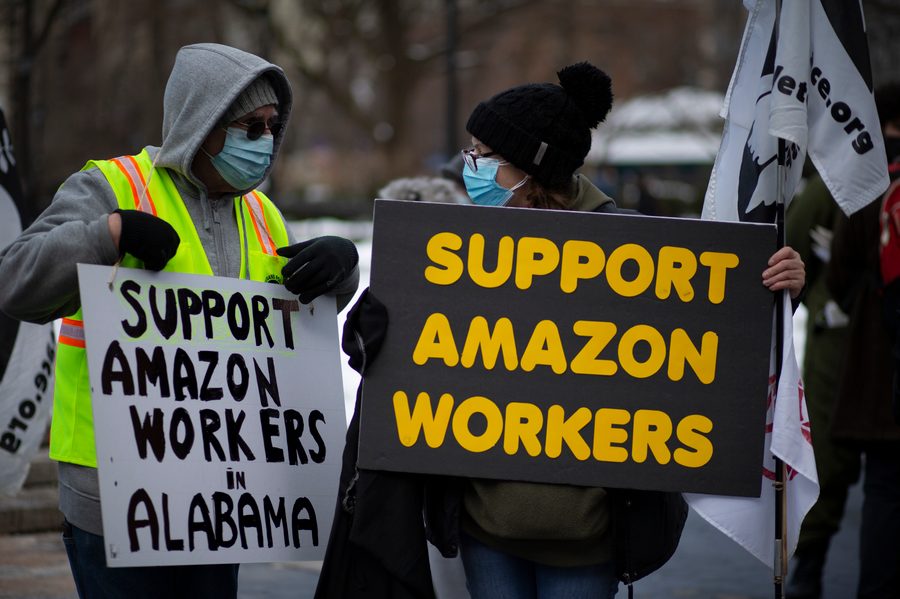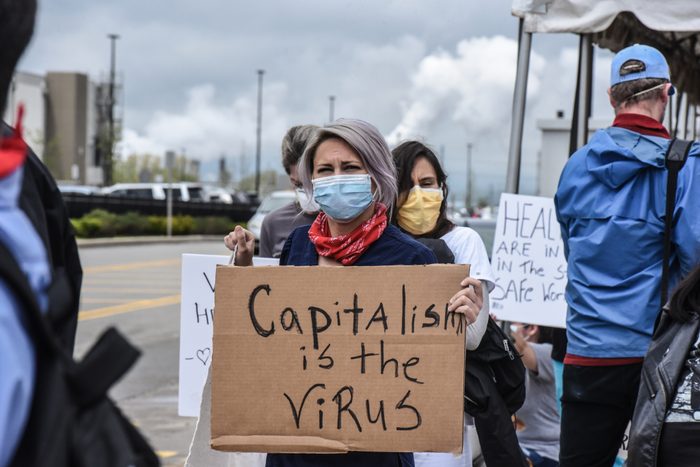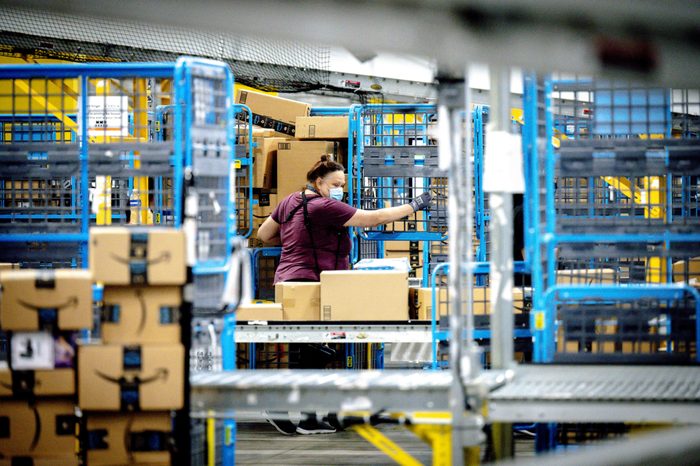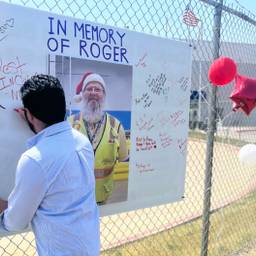“It Kind of Feels Like Prison”: Injured, Burned Out and Under Surveillance at Amazon
More than 40% of Amazon workers get injured on the job, according to a new report. The company says they are “industrial athletes.”
Katrina Pham

More than four in 10 Amazon workers report being injured on the job, and the number increases to more than half for those who have been working for the company for more than five years, according to a report released Wednesday.
Despite Amazon touting the grit of its “industrial athletes,” these widespread and pervasive injuries have, according to the survey, resulted in almost seven in 10 workers having to take unpaid time off from their jobs in the last month because of their pain or exhaustion from working at the company.
The report offers stark data of how Amazon, as a mammoth presence in the warehousing industry and customer service, can effectively set an unhealthy bar for the pace of production for its workers, and in doing so, also can impact the expectations of production and pace at other companies and warehouses. The unrelenting speed of work and the way warehouse workers are monitored, according to the report, deeply affects employees’ physical and mental health — and in some cases, costs them their lives.
“Your movements are being tracked. And then you have the cameras, a lot of cameras all around you,” says Wendy Taylor, an Amazon warehouse employee in St. Peters, Missouri. “It kind of feels like prison.”
The report, authored by Beth Gutelius and Sanjay Pinto and published by the University of Illinois-Chicago’s Center for Urban Economic Development, interrogated the physical and mental health and working conditions for more than 1,400 frontline Amazon workers in warehouses across the nation.
More than half of workers surveyed told researchers they are burned out from work — and that percentage increases by 10% for workers who have been with Amazon for more than five years.
The report also explained that nearly 80% of Amazon workers surveyed, at some point in their tenure, felt a sense of being watched or monitored at work. Workers also felt that Amazon’s surveillance was at a level higher than previous jobs they’ve worked, and almost half of workers surveyed said the surveillance is “mainly used to control or discipline.”
Amazon monitors its workers through technology that tracks a worker’s “takt time,” which refers to the average time it takes a worker to scan and process an item, and “idle time,” which is the amount of time a worker is not scanning items, according to the report.
“They appear to be setting that pace at the pace of a robot as opposed to the pace of a human,” says Gutelius. “Even as we sort of see Amazon signaling that they care about health and safety, and claiming that these technological advancements are going to improve health and safety, that has not been the pattern thus far.”
Amazon has made headlines across the country for its grueling work conditions and production rates. Lawmakers in some states, such as New York and California for example, have successfully implemented legislation about efforts to address Amazon’s productivity quotas that can lead employees to skip much-needed water or bathroom breaks.

Labor and other reporters such as Alex Press, Luis Feliz Leon and Sarah Lazare have long warned and published about the conditions of workers at Amazon.
The 2022 Jacobin article “Working at Amazon Is Hazardous to Your Health,” that Press wrote, highlighted that “injury rates last year at Amazon warehouses were 20% higher than the already alarmingly high 2020 rate — and more than twice that of non-Amazon warehouses.”
“There is no magic fix for Amazon’s safety issues. No far-fetched AmaZen wellness booths on the shop floor or algorithmic management of workers’ bodies can substitute for slowing down the pace of work,” Press wrote. “The effect Amazon’s quotas have on workers’ health and well-being is not news — the company has known about the issue for years, and whatever it has done to address it has not worked, as evidenced by the 2021 injury numbers.”
Feliz Leon, a staff writer and organizer at Labor Notes, wrote an article for In These Times in 2022 titled “These Are The Workers Who Took on Amazon, and Won” that noted that “Nationwide, workers at Amazon suffered 27,700 injuries in 2020 and 38,300 in 2021. The company accounts for nearly half of all injuries in the warehouse industry — a rate of 6.8 per 100 workers.”
A year before that, Feliz Leon wrote a piece for The New Republic, “Regulating Amazon’s Warehouse Algorithms Is About More Than Injuries,” that pointed out that Amazon made huge profits in 2020, with annual revenue up “nearly 40% to $386 billion.” Part of that increase is owed to high earnings from workers delivering packages to the company’s 147 million U.S. Amazon Prime subscribers during the plague-induced shutdown. And those workers have paid the price.”
The article then notes comments by a worker in East Los Angeles who describes “punishing productivity requirements” that “force workers to scan and sort some 450 boxes of various weights per hour,” a situation that leads “them to take shortcuts and, often, get injured as they rush to make the quota.”
“They’re breaking our bodies. Yeah, there is a high turnover rate, but why is that? Because they’re breaking us; they’re literally breaking us,” said the worker, Jaclyn Castro.
Feliz Leon writes that “‘Amazon Hurts’ has become a rallying cry emblazoned on protest signs in the United States and around the world,” and that “Amazon doesn’t deny its grueling work environment, where workers routinely suffer from musculoskeletal disorders caused by sprains and strains. It boasts about it — cynically dubbing workers ‘industrial athletes’ capable of walking 13 miles a day and lifting 20,000 pounds during any given shift.”

A joint investigation by In These Times and Workday Magazine by Sarah Lazare and Jeff Schuhrke in June found that, despite Amazon denying claims that a 59-year-old employee’s death in Joliet, Illinois, were work-related, high temperatures within the facility and work quota pressures that discouraged water breaks could have contributed to his death — and there was important evidence that may help prove that it did.
Taylor, the Amazon employee in Missouri, said she was also injured on the job, falling over a misplaced pallet and tearing the meniscus in her knee. Even though she was experiencing pain and swelling in her knee, the on-site first aid team, also known as AmCare, cleared Taylor for work and sent her back to her packing station — despite her repeated requests to see a doctor for care.
“It’s been a fight with them, and I shouldn’t have to fight with them because I got injured — not because of something I did, but because of something that somebody else didn’t do,” Taylor says. “Amazon didn’t keep us safe.”
Amazon’s brutal working conditions even alerted the Occupational Safety and Health Administration (OSHA) to launch investigations and issue citations of facilities in Colorado, Idaho, New York, Florida and Illinois. OSHA cited Amazon warehouses in New York, for example, with multiple “willful” violations that exposed workers to safety hazards, something Gutelius and Pinto wrote about in the report.
But citations issued by OSHA don’t tell the full story — and the vast majority of injuries on the job apparently go unreported. According to this most recent report, of those workers who were injured and took action afterwards, only 3% said they reported the injury directly to OSHA or a state agency.
When asked by In These Times about the report, Amazon spokesperson Maureen Lynch Vogel asserted, in part, that it was not a legitimate study and was done “by groups with an ulterior motive.”
Vogel suggested that people instead read the data that Amazon publishes itself and submits to OSHA annually “which shows that rates in our buildings have improved significantly and we’re slightly above the average in some areas and slightly below the average in others.”
Moving forward, the report’s authors point to the need for greater legislative protections for workers, reforms at Amazon and OSHA, and stressed the priority of centering and uplifting worker’s voices in the industry.
“Amazon is talked about and talks about itself as a great innovator and disrupter … often focusing on the ways in which these delivery processes benefit consumers,” Pinto says. “What our report points to is the hidden toll — the cost that comes along with that single-minded focus on speed and efficiency.”
As health and safety violations persist, Amazon workers like Taylor, who are organizing in unions and making their voices heard, continue to advocate for themselves and future generations of workers in the industry.
Taylor is a part of the Missouri Workers Center, a coalition of low-wage workers in Missouri advocating for worker’s rights and economic justice. The center is also a part of the Athena Coalition, a watchdog organization advocating for reform at Amazon.
“One day that could be my kids or my grandkids or somebody else’s,” Taylor says. “I want everybody to have a better work environment, a safer work environment and [to be] treated with respect and dignity.”
“I don’t think that’s a whole lot to even ask for.”







